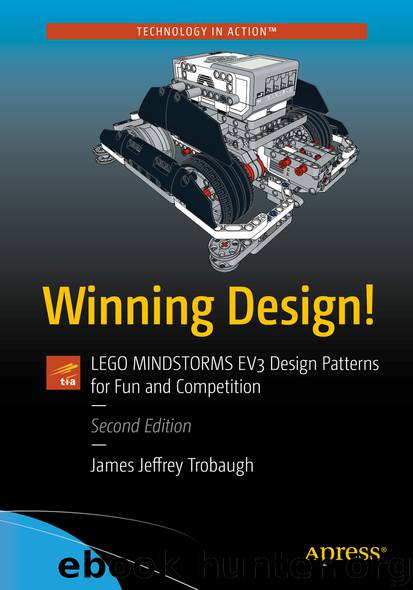Winning Design! by James Jeffrey Trobaugh

Author:James Jeffrey Trobaugh
Language: eng
Format: epub
Publisher: Apress, Berkeley, CA
First, I’ll discuss some general ideas on finding lines. Then I’ll explain how color lines appear to an EV3 Color Sensor.
Finding a Line
If you take a look at the 2008 FIRST LEGO League Climate Connections field mat, as shown in Figure 5-14, you will see that it doesn’t have a lot of lines that would be helpful for line following. However, there are lots of thick lines that either outline or could guide a robot to a particular location on the field. These lines aren’t there just to look pretty. They are there for you to use to help your robot navigate to particular locations. In the middle of the field, you will see a lot of open space, and it would be very easy for your robot to get lost in this space. Having the borders enables you to better program your robot to detect when it has reached a location that you are targeting.
Say, for example, your robot leaves base and is heading to the location I’ve marked as Zone A in Figure 5-14. After the robot leaves base, it will be very dependent on odometry to find its way across the field. During this time, it should start looking for the thick black border around Zone A using its Color Sensor. You will have to be careful that the other colors on the field don’t confuse your robot. In real life, that rainbow at the bottom of Figure 5-14 tripped up many robots. You need to think, when planning the task for your missions, about what things can be in your way. What other markings on the mat can confuse your robot?
Now let’s look at the FIRST LEGO League 2015 Trash Trek field mat, as shown in Figure 5-15. It was very different from the 2008 Climate Connections mat in that it had much better-defined zones with easy-to-track borders. There were a few black lines that you could use for line following plus they were great for breaking up the different areas of the mat, giving your robot quick feedback for where it was located currently on the field. Notice the two obvious black lines crossing the robot’s path as it leaves base heading east. Counting these lines is a great way to help the robot learn where it is located.
Figure 5-15.The 2015 FIRST LEGO League Trash Trek field mat
Download
This site does not store any files on its server. We only index and link to content provided by other sites. Please contact the content providers to delete copyright contents if any and email us, we'll remove relevant links or contents immediately.
Algorithms of the Intelligent Web by Haralambos Marmanis;Dmitry Babenko(9832)
Test-Driven Development with Java by Alan Mellor(7661)
Data Augmentation with Python by Duc Haba(7544)
Principles of Data Fabric by Sonia Mezzetta(7320)
Learn Blender Simulations the Right Way by Stephen Pearson(7236)
Microservices with Spring Boot 3 and Spring Cloud by Magnus Larsson(7071)
RPA Solution Architect's Handbook by Sachin Sahgal(6461)
Jquery UI in Action : Master the concepts Of Jquery UI: A Step By Step Approach by ANMOL GOYAL(6447)
The Infinite Retina by Robert Scoble Irena Cronin(6171)
Hadoop in Practice by Alex Holmes(6138)
Big Data Analysis with Python by Ivan Marin(5886)
Life 3.0: Being Human in the Age of Artificial Intelligence by Tegmark Max(5474)
Pretrain Vision and Large Language Models in Python by Emily Webber(4843)
Infrastructure as Code for Beginners by Russ McKendrick(4625)
WordPress Plugin Development Cookbook by Yannick Lefebvre(4343)
Functional Programming in JavaScript by Mantyla Dan(4216)
The Age of Surveillance Capitalism by Shoshana Zuboff(4210)
Embracing Microservices Design by Ovais Mehboob Ahmed Khan Nabil Siddiqui and Timothy Oleson(4114)
Applied Machine Learning for Healthcare and Life Sciences Using AWS by Ujjwal Ratan(4094)
